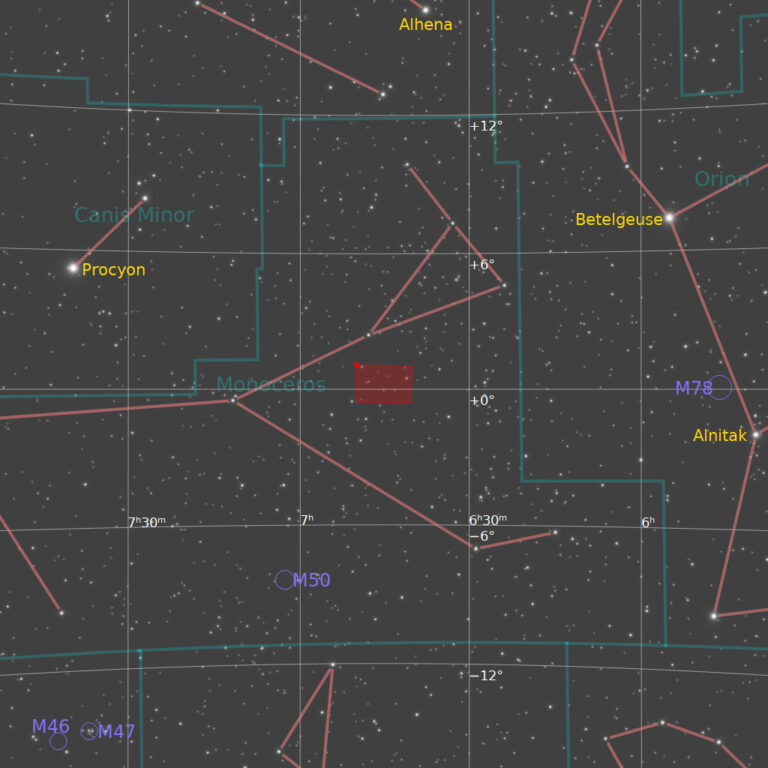Sh2-284
Emission Nebula, Monoceros
- Description
- Technical
- Links
Sh2-284 is a large emission nebula in the constellation Monoceros. It is located in the east-central part of the constellation, about 5° southeast of the Rosetta Nebula. It can be seen and photographed through a high-power amateur telescope equipped with special filters. Being almost straddling the celestial equator, it can be observed from all populated areas of the Earth with ease without any privileges; The best time to observe it in the evening sky is from December to April.
It is a large H II region, the distance of which has long been debated: during the 1980s, a distance of about 5200 parsecs (about 16950 light-years) was proposed, thus placing it in an intermediate region between the Perseus Arm and the Swan Arm; In 2007, through the study of the dynamics of galactic spiral arms, the cloud was assigned a distance of 7890 parsecs, equal to about 25720 light years, therefore in the outermost regions of the Milky Way, on the Cygnus Arm, also called the Outer Arm. The center of the nebula hosts the large open cluster Dolidze 25 (Do 25), in fact an OB association composed of a blue giant of spectral class O9 and four more or less massive stars of class B, including a subgiant; these five stars, catalogued as Cl* Dolidze 25 MV 1, 9, 12, 15 and 17, are also the main ones responsible for the ionization of the gases of Sh2-284.
The stars in the region are all very metal-poor, a feature relatively common to stars in the outer regions of the Milky Way. Star formation phenomena are also active in the cloud, as evidenced by the presence of a large number of infrared radiation sources, over thirty, coinciding with as many very young protostars and pre-main sequence stars. According to a 2007 study, Sh2-284 is physically connected to other nebulous regions visible at a short distance from it, such as Sh2-283, Sh2-285, and Sh2-286.
In the line of sight of the nebula is a tangle of gaseous filaments belonging to a supernova remnant, cataloged as SNR G213.0-00.6; this object is in the foreground, about 2400 parsecs (about 7820 light-years) away from the Sun, and would therefore be part of the Perseus Arm. The two objects are therefore not physically linked.
The stars in the region are all very metal-poor, a feature relatively common to stars in the outer regions of the Milky Way. Star formation phenomena are also active in the cloud, as evidenced by the presence of a large number of infrared radiation sources, over thirty, coinciding with as many very young protostars and pre-main sequence stars. According to a 2007 study, Sh2-284 is physically connected to other nebulous regions visible at a short distance from it, such as Sh2-283, Sh2-285, and Sh2-286.
In the line of sight of the nebula is a tangle of gaseous filaments belonging to a supernova remnant, cataloged as SNR G213.0-00.6; this object is in the foreground, about 2400 parsecs (about 7820 light-years) away from the Sun, and would therefore be part of the Perseus Arm. The two objects are therefore not physically linked.
Telescope: Astro Physics 155EDF (TCC) f5.4
Mount: Astro Physics 1600GTO
Camera: FLI PL29050 / CFW2-7
Guider: Agena Starguide II / ZWO ASI178MM
Filters: Astrodon II 50mm LRGB
L: 53×10 mins = 530 mins, R: 24×10 mins = 240 mins, G: 24×10 mins = 240 mins, B: 24×10 mins = 240 mins
Total Imaging Time: 20h 50m
Data Imaged remotely on 5 nights during January 2024.
Imaged from Observatorio El Sauce, Chile, in partnership with Fred Espenak.
Data acquisition & Processing by David Churchill.
None


